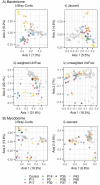Association between ustekinumab therapy and changes in specific anti-microbial response, serum biomarkers, and microbiota composition in patients with IBD: A pilot study
- PMID: 36584073
- PMCID: PMC9803183
- DOI: 10.1371/journal.pone.0277576
Association between ustekinumab therapy and changes in specific anti-microbial response, serum biomarkers, and microbiota composition in patients with IBD: A pilot study
Abstract
Background: Ustekinumab, is a new therapy for patients with IBD, especially for patients suffering from Crohn's disease (CD) who did not respond to anti-TNF treatment. To shed light on the longitudinal effect of ustekinumab on the immune system, we investigated the effect on skin and gut microbiota composition, specific immune response to commensals, and various serum biomarkers.
Methodology/principal findings: We recruited 11 patients with IBD who were monitored over 40 weeks of ustekinumab therapy and 39 healthy controls (HC). We found differences in the concentrations of serum levels of osteoprotegerin, TGF-β1, IL-33, and serum IgM antibodies against Lactobacillus plantarum between patients with IBD and HC. The levels of these biomarkers did not change in response to ustekinumab treatment or with disease improvement during the 40 weeks of observation. Additionally, we identified differences in stool abundance of uncultured Subdoligranulum, Faecalibacterium, and Bacteroides between patients with IBD and HC.
Conclusion/significance: In this preliminary study, we provide a unique overview of the longitudinal monitoring of fecal and skin microbial profiles as well as various serum biomarkers and humoral and cellular response to gut commensals in a small cohort of patients with IBD on ustekinumab therapy.
Copyright: © 2022 Rob et al. This is an open access article distributed under the terms of the Creative Commons Attribution License, which permits unrestricted use, distribution, and reproduction in any medium, provided the original author and source are credited.
Conflict of interest statement
The authors have declared that no competing interests exist.
Figures






Similar articles
-
Fecal Microbiota Signatures Are Associated with Response to Ustekinumab Therapy among Crohn's Disease Patients.mBio. 2018 Mar 13;9(2):e02120-17. doi: 10.1128/mBio.02120-17. mBio. 2018. PMID: 29535202 Free PMC article.
-
Skin microbiota signature distinguishes IBD patients and reflects skin adverse events during anti-TNF therapy.Front Cell Infect Microbiol. 2023 Jan 10;12:1064537. doi: 10.3389/fcimb.2022.1064537. eCollection 2022. Front Cell Infect Microbiol. 2023. PMID: 36704107 Free PMC article.
-
Inflammatory Bowel Disease Types Differ in Markers of Inflammation, Gut Barrier and in Specific Anti-Bacterial Response.Cells. 2019 Jul 13;8(7):719. doi: 10.3390/cells8070719. Cells. 2019. PMID: 31337064 Free PMC article.
-
Anti-IL-12/23p40 antibodies for maintenance of remission in Crohn's disease.Cochrane Database Syst Rev. 2019 Dec 12;12(12):CD012804. doi: 10.1002/14651858.CD012804.pub2. Cochrane Database Syst Rev. 2019. PMID: 31828765 Free PMC article.
-
Review article: predictors of response to vedolizumab and ustekinumab in inflammatory bowel disease.Aliment Pharmacol Ther. 2018 Apr;47(7):896-905. doi: 10.1111/apt.14550. Epub 2018 Feb 12. Aliment Pharmacol Ther. 2018. PMID: 29430672 Review.
Cited by
-
Interplay of Gut Microbiota, Biologic Agents, and Postoperative Anastomotic Leakage in Inflammatory Bowel Disease: A Narrative Review.Int J Mol Sci. 2025 Jul 22;26(15):7066. doi: 10.3390/ijms26157066. Int J Mol Sci. 2025. PMID: 40806196 Free PMC article. Review.
-
Baseline Peripheral Blood Mononuclear Cell Transcriptomics Before Ustekinumab Treatment Is Linked With Crohn's Disease Clinical Response at 1 Year.Clin Transl Gastroenterol. 2023 Dec 1;14(12):e00635. doi: 10.14309/ctg.0000000000000635. Clin Transl Gastroenterol. 2023. PMID: 37655708 Free PMC article.
-
The Role of Gut Microbiota in the Efficacy and Side Effect Profile of Biologic Therapies for Autoimmune Diseases.Cureus. 2024 Oct 8;16(10):e71111. doi: 10.7759/cureus.71111. eCollection 2024 Oct. Cureus. 2024. PMID: 39525264 Free PMC article. Review.
-
Pharmacoepigenetic Biomarkers in Inflammatory Bowel Diseases: A Narrative Review.Yale J Biol Med. 2025 Jun 30;98(2):171-186. doi: 10.59249/FTXB7704. eCollection 2025 Jun. Yale J Biol Med. 2025. PMID: 40589936 Free PMC article. Review.
References
Publication types
MeSH terms
Substances
LinkOut - more resources
Full Text Sources
Medical
Molecular Biology Databases

